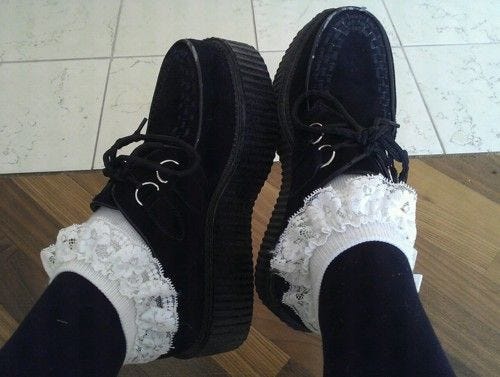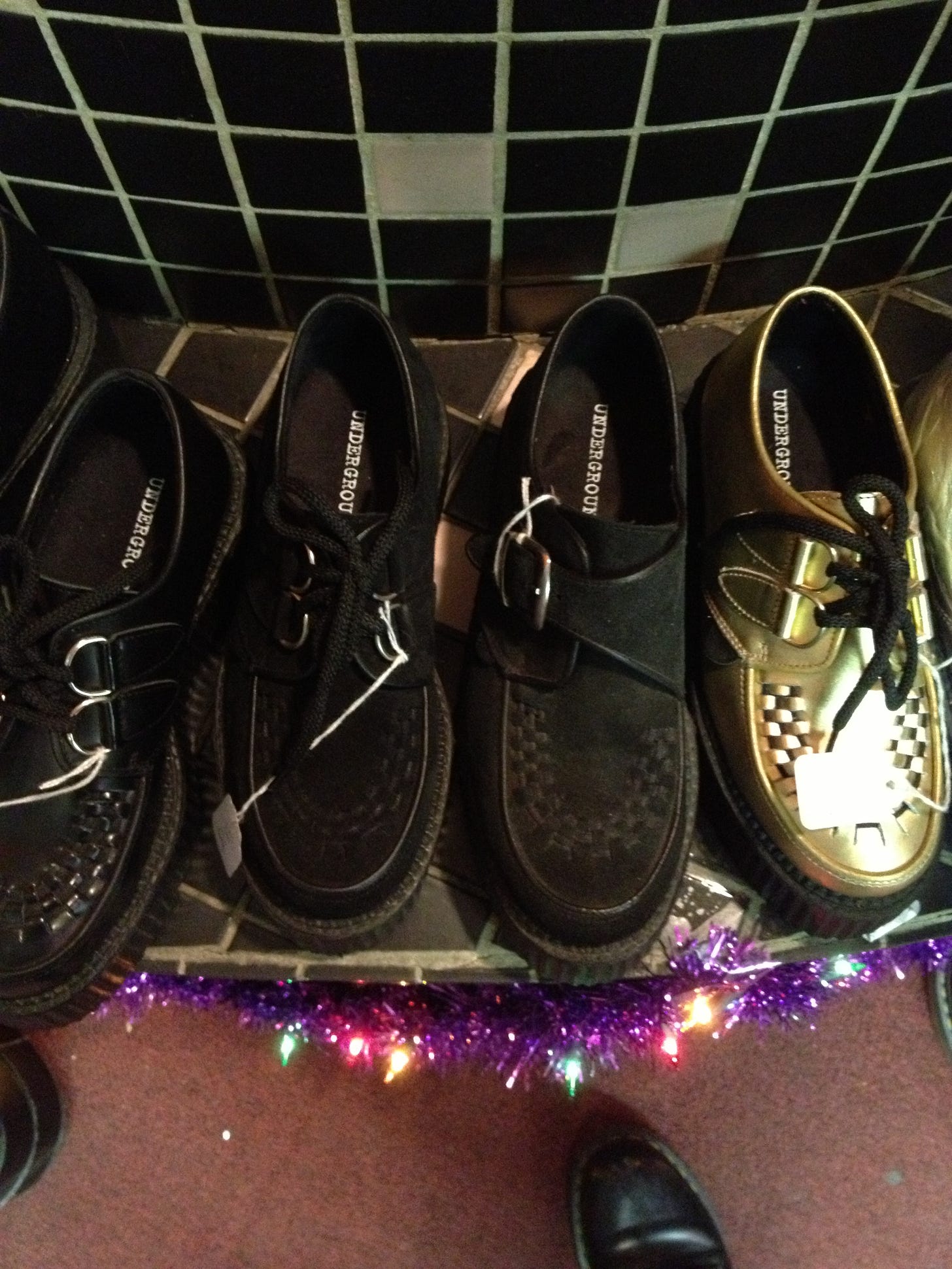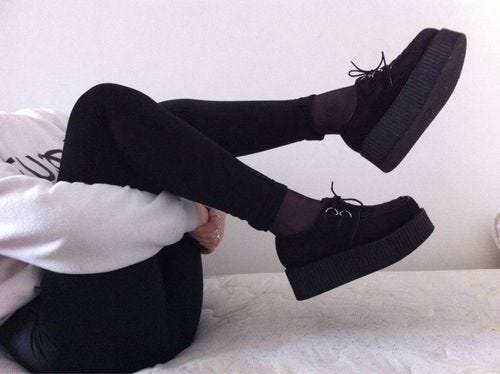I first heard about creepers back in 2013. A baby emo blossoming her fashion interests led to new obsessions with 70s punk, 90s grunge, and then-present iterations of soft grunge, pizza punk, and pastel goth. I constantly reblogged photos of thin, pale girls wearing creepers on Tumblr. There was no way my parents would buy me a pair as their money was reserved for practical clothing and I was doomed to suffer the life of a Jorge quiere ser hardcore pero su mama no lo deja girl. But now, I’m an adult, with money that I can spend on things that will heal my inner teen, so I just bought my first pair of creepers.
With all the talk about 2014 Tumblr coming back (or wishing it would) I thought I would unbox them on TikTok. Creepers were one of the defining trends of 2014 fashion, but just because something is a trend at a certain point in time doesn’t mean it doesn’t hold permanence in fashion or history. None of the comments on my video are mean per se (I’m just a cancer rising and don’t want to be misinterpreted), but I do want to clarify for the alt baddies in the comments that, yes, creepers have always been in.
Way before they became staples of the 2014 Tumblr era, creepers have been at the center of alternative fashion movements since their inception. So I’m feeling inspired to share a bit about the history of creepers and the fashion movements that have adopted it as its shoe de jour.
A Brief History
The cooler, underrated best friend of Dr. Marten, creepers also have a wartime origin story. Originally worn in the North African deserts by British soldiers during World War II, thick-soled crepe boots were practical for dealing with extreme heat and sandy terrain. After the war, these boots along with soldiers made their way back to England and gradually became a fashionable footwear choice. Observing the increasing popularity of these boots among ex-soldiers and civilians, shoe manufacturers like Denson and Ladd’s were inspired to create the Creeper, also known as the 'Brothel Creeper.' It’s unsure where the nickname 'Brothel Creepers' came from, but legend has it that after returning from war, some soldiers sought adult entertainment in the back streets of Soho in London, sporting their creeper shoes.
Edwardians / Teddy Boys
The Teddy Boys were probably the first youth subculture to adopt the creeper as part of their uniform and played a pivotal role in popularizing the Creeper as a fashion statement. Emerging in the 50s in post-war Britain, Teddy Boys were recognizable for their dandy-inspired style. They embraced a rebellious and flamboyant look that included tailored Edwardian-style suits, zoot suits like the ones worn by Chicano Americans, narrow trousers, bolo ties, and creepers. This subculture contributed significantly to the widespread adoption of the Creeper, turning it into an iconic element of their rebellious and stylish identity.
Rockabillies, Bikers, Rockers
Not totally post-teddy boy, but soon after, the Creeper found a following among Rockabillies, bikers, and rockers, becoming an integral part of their distinctive fashion. Rockabillies, enthusiasts of the 1950s rock and roll culture, embraced the Creeper for its retro appeal, often pairing it with rolled-up jeans and leather jackets. Meanwhile, bikers, synonymous with freedom and rebellion, adopted the Creeper as a symbol of non-conformity, blending it into their rugged aesthetic.
Rockers, who emerged in the 1960s as a counter-cultural response to mainstream norms, also incorporated the Creeper into their wardrobe, complementing their leather-clad style. The Creeper's versatility allowed it to transcend subcultures and become a unifying element among these groups, each contributing to its enduring popularity and iconic status in the realm of alternative fashion.
Punk
Punks, the anti-establishment subculture that emerged in the mid-1970s, characterized by their rebellion and DIY ethos, adopted unconventional styles as a way to challenge societal norms. The Creepers’ reputation as a shoe for the counterculture aligned with the punk aesthetic of non-conformity. Punks often customized their Creepers, adding studs, spikes, and paint to reflect their individuality and disdain for traditionalism.
Tumblr
Tumblr and the associated alt-Tumblr aesthetics, including soft grunge, played a huge role in the adoption of the Creeper shoe within alternative internet aesthetics. The platform was a hub for subcultures to share and shape styles. Soft grunge emerged as a notable aesthetic characterized by its dreamy, nostalgic, and sometimes messy visuals. The Creeper shoe, with its retro appeal, integrated into the soft grunge and alt-Tumblr fashion scenes. Influenced by a mix of vintage and contemporary elements, Tumblr girls embracing these aesthetics often paired Creepers with oversized sweaters, ripped jeans, and frilly socks. The Creeper's ability to blend nostalgia with a contemporary edge resonated with those seeking a distinctive and personalized style within the digital realms of Tumblr and alternative online communities, further establishing its place as a timeless and adaptable fashion choice.
Modern Alt Movements
Today, all of these subcultures exist in some way shape, or form, whether you follow them to a T or borrow from them in your personal style. Modern day punks, rockabillies, emos, and others that fall under the umbrella of alt subcultures have been wearing creepers before, since, and long after 2014.
Long live creepers 🖤
Source: https://www.tukshoes.co.uk/pages/history-of-creepers







